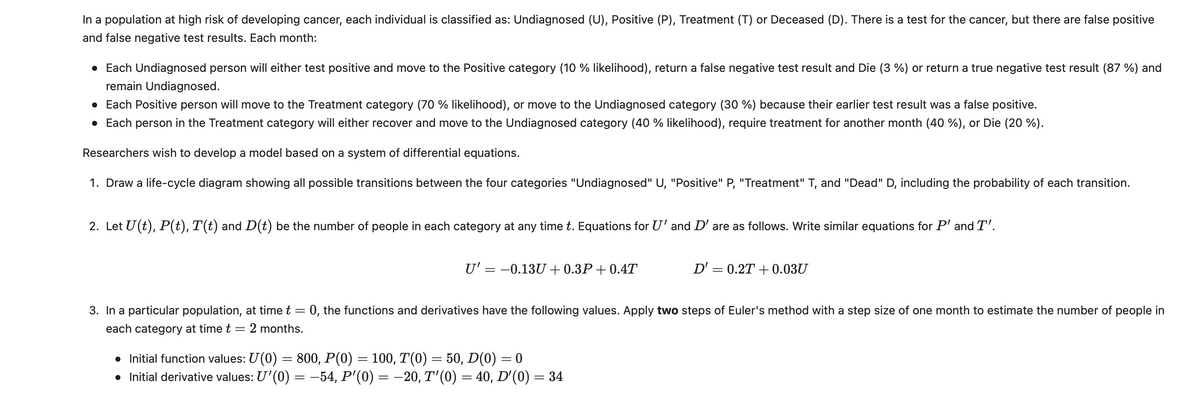In a population at high risk of developing cancer, each individuali classified as: Undiagnosed (U), Positive (P), Treatment (T) or Deceased (D). There is a test for the cancer, but there are false positive and false negative test results. Each month: • Each Undiagnosed person will either test positive and move to the Positive category (10 % likelihood), return a false negative test result and Die (3 %) or return a true negative test result (87 %) and remain Undiagnosed. • Each Positive person will move to the Treatment category (70 % likelihood), or move to the Undiagnosed category (30 %) because their earlier test result was a false positive. • Each person in the Treatment category will either recover and move to the Undiagnosed category (40 % likelihood), require treatment for another month (40 %), or Die (20 %). Researchers wish to develop a model based on a system of differential equations. 1. Draw a life-cycle diagram showing all possible transitions between the four categories "Undiagnosed" U, "Positive" P, "Treatment" T, and "Dead" D, including the probability of each transition. 2. Let U(t), P(t), T(t) and D(t) be the number of people in each category at any time t. Equations for U' and D' are as follows. Write similar equations for P' and T'. U' -0.13U+0.3P+0.4T D'= 0.2T+0.03U
In a population at high risk of developing cancer, each individuali classified as: Undiagnosed (U), Positive (P), Treatment (T) or Deceased (D). There is a test for the cancer, but there are false positive and false negative test results. Each month: • Each Undiagnosed person will either test positive and move to the Positive category (10 % likelihood), return a false negative test result and Die (3 %) or return a true negative test result (87 %) and remain Undiagnosed. • Each Positive person will move to the Treatment category (70 % likelihood), or move to the Undiagnosed category (30 %) because their earlier test result was a false positive. • Each person in the Treatment category will either recover and move to the Undiagnosed category (40 % likelihood), require treatment for another month (40 %), or Die (20 %). Researchers wish to develop a model based on a system of differential equations. 1. Draw a life-cycle diagram showing all possible transitions between the four categories "Undiagnosed" U, "Positive" P, "Treatment" T, and "Dead" D, including the probability of each transition. 2. Let U(t), P(t), T(t) and D(t) be the number of people in each category at any time t. Equations for U' and D' are as follows. Write similar equations for P' and T'. U' -0.13U+0.3P+0.4T D'= 0.2T+0.03U
Holt Mcdougal Larson Pre-algebra: Student Edition 2012
1st Edition
ISBN:9780547587776
Author:HOLT MCDOUGAL
Publisher:HOLT MCDOUGAL
Chapter11: Data Analysis And Probability
Section: Chapter Questions
Problem 8CR
Related questions
Question

Transcribed Image Text:In a population at high risk of developing cancer, each individual is classified as: Undiagnosed (U), Positive (P), Treatment (T) or Deceased (D). There is a test for the cancer, but there are false positive
and false negative test results. Each month:
• Each Undiagnosed person will either test positive and move to the Positive category (10 % likelihood), return a false negative test result and Die (3 %) or return a true negative test result (87%) and
remain Undiagnosed.
• Each Positive person will move to the Treatment category (70 % likelihood), or move to the Undiagnosed category (30 %) because their earlier test result was a false positive.
• Each person in the Treatment category will either recover and move to the Undiagnosed category (40 % likelihood), require treatment for another month (40 %), or Die (20 %).
Researchers wish to develop a model based on a system of differential equations.
1. Draw a life-cycle diagram showing all possible transitions between the four categories "Undiagnosed" U, "Positive" P, "Treatment" T, and "Dead" D, including the probability of each transition.
2. Let U(t), P(t), T(t) and D(t) be the number of people in each category at any time t. Equations for U' and D' are as follows. Write similar equations for P' and T'.
U' = -0.13U+0.3P+0.4T
D' = 0.2T+0.03U
3. In a particular population, at time t = 0, the functions and derivatives have the following values. Apply two steps of Euler's method with a step size of one month to estimate the number of people in
each category at time t = 2 months.
● Initial function values: U(0) = 800, P(0) = 100, T(0) = 50, D(0) = 0
• Initial derivative values: U'(0) = −54, P′(0) = −20, T'(0) = 40, D′(0) = 34
Expert Solution
This question has been solved!
Explore an expertly crafted, step-by-step solution for a thorough understanding of key concepts.
Step by step
Solved in 4 steps with 1 images

Recommended textbooks for you

Holt Mcdougal Larson Pre-algebra: Student Edition…
Algebra
ISBN:
9780547587776
Author:
HOLT MCDOUGAL
Publisher:
HOLT MCDOUGAL


Holt Mcdougal Larson Pre-algebra: Student Edition…
Algebra
ISBN:
9780547587776
Author:
HOLT MCDOUGAL
Publisher:
HOLT MCDOUGAL
